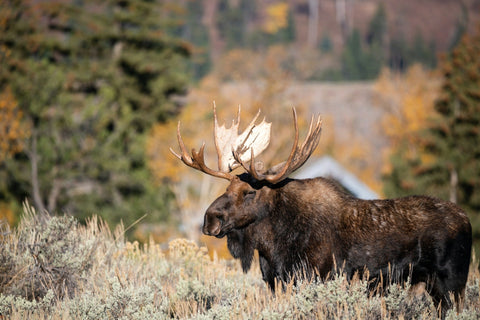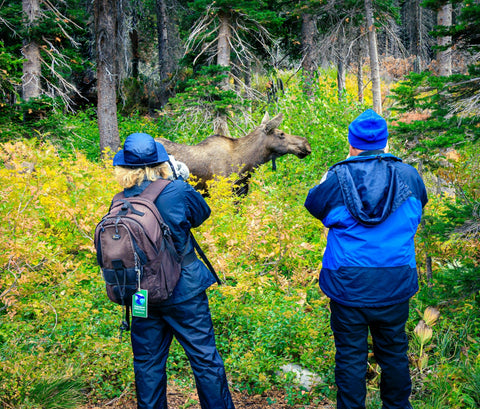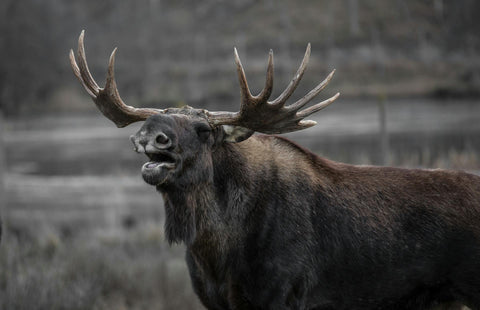Moose are mighty creatures: the biggest members of the deer (or cervid) family and, after the American bison, the second-largest terrestrial mammal in North America. From the Lakeland backcountry of Maine and the North Woods of the Upper Midwest to the Rocky Mountains, these towering ungulates rank among the quintessential, iconic symbols of northern and mountain wilderness.
Sure, moose are devotedly herbivorous, munching roughage that ranges from lean winter twigs and conifer needles to fresh green shoots and aquatic plants. Yet these plant-eaters rank among the more dangerous animals on the continent, injuring more people in Alaska on average than bears do each year.
In this guide, we’ll help you stay safe around this impressive and inspiring beast: always a thrill to see, especially when you’re confident you won’t get trampled—and that you’re not stressing the animal out.
Introducing the Moose
The giant deer, referred to as "moose" in North America, originating from an Ojibwe-Cree term, is known as "elk" in most of Eurasia. It is a circumboreal species, found from Scandinavia to Siberia and from Alaska to Utah and Massachusetts. The nomenclatural confusion intensifies on account that the second-largest member of the deer family is widely called “elk” in North America, though the indigenous name “wapiti” would be preferable.
Size
Moose reach their greatest dimensions in North America, specifically in the form of the Alaskan-Yukon subspecies. Bulls there may weigh more than 1,800 pounds and brandish palmate antlers 6.5 feet or more across. Even the smallest North American subspecies of moose, the Shiras moose, which is found in the Rocky Mountains and parts of the Northwest, commonly weighs 700 to 800 pounds, with big Shiras bulls exceeding a half-ton.
(The smallest moose subspecies in the world is the Manchurian or Ussuri moose of East Asia, which tends to max out around 550 to 660 pounds.)
Look
Moose aren’t only distinctive amid the deer clan for their great size. They’ve also got a singular look: remarkably long-legged, hump-shouldered, stiffly maned, and possessing a droopy, bulbous snout. Those gangly legs help them navigate the deep snowpacks that define the winter landscape across much of their range. Compared with other North American cervids moose are darker-colored, nearly black across much of the coat, with lighter legs and rump. Their palmate antlers are also unmistakable (though similar-looking to those of the exotic fallow deer, which is naturalized in some parts of the continent.)
Temperament
Behaviorally speaking, too, moose sort of stand-alone. Literally, they’re much more solitary than elk, mule deer, or white-tailed deer.
Big (downright ginormous) as they are, moose do face the real threat of predators. Gray wolves are their most important non-human predator in both North America and Eurasia, but bears—especially brown/grizzly bears—also pose a threat, most significantly to calves but also sometimes adults. Mountain lions (aka cougars or pumas) have also been documented preying on moose in North America.
But moose are not easy prey, and not only because of their size. They tend to be more aggressive than other deer species. Sure, a moose may flee from a wolf pack; those stalk-like legs give them an advantage running through deep snow or downfall timber, for one thing. But moose are also just as apt to stand and fight—not least a cow moose defending her calf from a wolf or bear. A moose kicking out and stomping with its front hooves or hind legs can be lethal.
When it comes to humans, moose—like most other wild animals—are not disposed to seek out confrontations. But when they feel their personal space is being invaded, they may absolutely confront a hiker (or a hunter). And an ornery moose can be just about as terrifying as a riled-up grizzly bear.
Dealing With Moose Encounters
Give moose plenty of room—that’s true of any wild creature, of course, but few wild creatures are quite so well-armed and capable of inflicting bodily damage as a full-grown moose.
Keep Your Distance
If you encounter a moose on a trail, give it the time and the space to move out of the vicinity on its own or—if possible and not environmentally destructive—make a wide detour around it. The National Park Service recommends staying at least 25 yards away from a moose, and being even more cautious if you see a mother and her calf.
Look for Warnings
Watch for signs of disturbance and defensiveness. An agitated or threatened-feeling moose may raise its hackles, lower its head, flatten its ears, and lick its lips. It might slowly walk stiff-legged in your direction. These are all big-time warning signs that you ought to be making yourself scarce.
Be Extra Careful During Mating Season
A moose can be dangerous any time of year, in any situation. That said, as the Alaskan Department of Fish & Game notes point out, there are seasons when you ought to be especially alert for aggression. In the late spring and early summer, cow moose may be exceedingly touchy (understandably so) over their calves, vulnerable as they are to multiple predators. A cow energized by her motherly instinct to protect her offspring is just about the deadliest moose you could deal with.
But a bull moose during the fall rut is also nothing to be trifled with. These hormone-roiled animals, in their peak condition and ready to tussle, antler-to-antler, with rivals, can be unpredictable and cantankerous.
The main thing is to stay watchful and aware while hiking in moose country and enjoy the sight of these supersized creatures at a safe distance. If you do so, you’re unlikely to provoke a defensive reaction. We should also emphasize that giving moose plenty of room isn’t just for your own self-preservation: It also avoids or minimizes stressing the animals, which can waste precious energy fleeing, confronting, or even just being unnerved about too-close human presence.
If a Moose Attacks
If you’re charged or even just approached by, say, a bear or a cougar, you need to stand your ground. That’s not true if a moose comes at you full-tilt.
The best course of action when confronted by a charging moose is to run like heck. Make some sharp turns, and try to put an obstacle—a large tree, a rock outcrop, what have you—in between you and that enraged animal.
If you’re unfortunate enough to come into physical contact with the marauding moose, curl into a ball to protect your head and vital organs. You may be kicked and stomped on—not fun, to say the least—but a moose is unlikely to extend an attack for very long. Once it’s convinced you’re not a threat, it’s going to break off the assault and move on.
Enjoy Mountain House in That Magnificent Moose Country
Whether you’re hunting moose or simply enjoying their typically lovely wildland habitat—and hoping to spot one at a respectful distance—look no further than Mountain House for the best in freeze-dried outdoor fare: the go-to choice for generations of hikers and campers as well as sportsmen and women!






















































